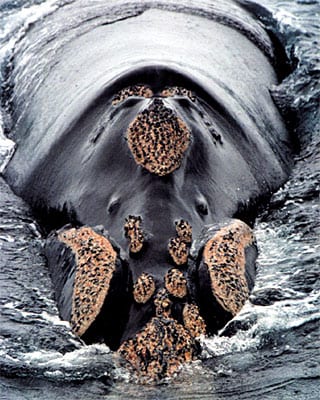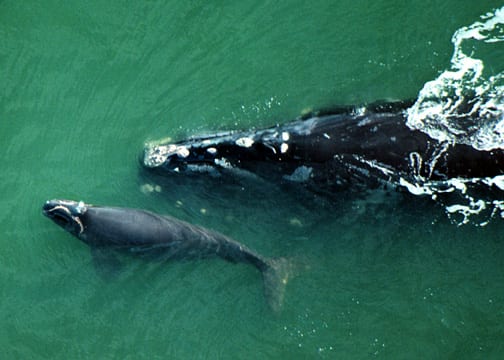Endangered North Atlantic Right Whale Study Shows Sharp Decline in Mothers
November 29, 2001
Scientists from the Woods Hole Oceanographic Institution (WHOI) report in today’s issue of the journal Nature that the population growth rate of North Atlantic Right whales has declined below replacement level because of increased mortality rates of mothers. The population numbers only about 300 and is predicted to become extinct within 200 years if the environmental conditions experienced by the whales in 1995 were maintained.
Study co-authors Masami Fujiwara and Hal Caswell of the Institution’s Biology Department found that male survival rates in the population have remained steady over the past two decades, but females are in trouble. Their data show the female survival rate, especially for females that have just given birth, is going down at an alarming rate, and they are not sure why.
The authors say that during the early 1980s, the life expectancy of female North Atlantic right whales was twice that of males. Female life expectancy, however, has declined from about 52 years in 1980 to about 15 years in 1995. Likewise, the scientists say that the expected number of reproductive events during a female’s lifetime has declined, from about 5 in 1980 to 1 in 1995.
“A mature female could once be expected to reproduce six times, but that number is now less than two,” says Fujiwara, a student in the MIT/WHOI Joint Graduate Program in Oceanography and Applied Ocean Sciences and Engineering. “Just saving two females a year from death can have a huge impact on this population.”
Using population models, the WHOI team predicts that extinction of this population, now less than 300, could occur within 200 years. They used more than 10,000 sightings of photographically identified individuals, collected by the New England Aquarium between 1980 and 1996, to estimate trends in this right whale population. Individual right whales can be recognized by natural markings such as scars and patterns of bumps, called callosities, on their heads. Fujiwara and Caswell then used those estimates to construct population models, which showed the survival probability for mothers in serious decline compared to that for other females and males.
The study was funded by the Institution’s Sea Grant Program and Rinehart Coastal Research Center, the David and Lucile Packard Foundation, and The Robert W. Morse Chair. The latter is an endowed position for senior scientists at the Institution and is currently held by Hal Caswell.
Right whale conservation efforts are aimed at reducing mortality due to entanglement in fishing gear and ship collisions. Availability of food due to climate fluctuations, such as the North Atlantic Oscillation, a major regional climate pattern that is just beginning to be understood, is also suspected as a cause of mortality. The authors say studies of the effects of all three factors on the population are urgently needed.
“Because the population is so small, a single death represents a significant mortality rate,” Caswell, a senior scientist at the Institution, notes. “Just preventing the deaths of two females a year, and maintaining survival of the rest, can make a huge difference.”
Right whales are distributed from the coast of northern Florida to the Bay of Fundy, with females and calves most often seen in winter months off the coast of Florida and Georgia, their only known calving ground. That area is also close to shipping lanes where large vessel traffic has increased since 1980. More than 60 percent of the North Atlantic right whales have scars from entanglement in fishing gear, such as lobster pots and sink gillnets. Cuts from ship strikes are also visible on many whales.
Although it is not clear why the survival rate for mothers is in such sharp decline, the authors say mother right whales spend about a year nursing their calves. They generally remain in coastal waters, in the same place as fishing boats and commercial vessels.
“The declining trend in the survival of mothers is real, and is a great concern,” Fujiwara says. “However, we are encouraged by the unprecedented calf production this past spring (2001). We found a positive growth rate in the early 1980s. That tells us that there is every reason to hope that prompt management intervention can improve the survival enough to permit the recovery of the North Atlantic right whale.”


